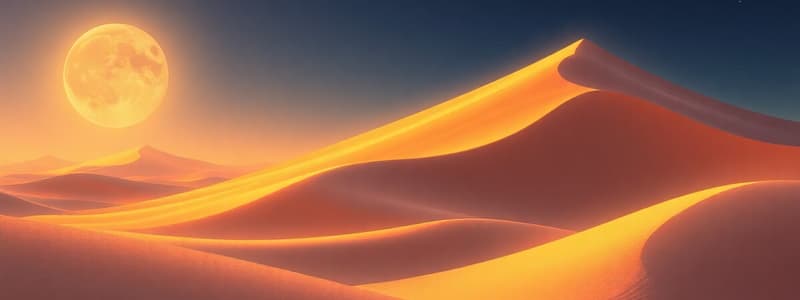Podcast
Questions and Answers
What is the primary shape of a Barkhan sand dune?
What is the primary shape of a Barkhan sand dune?
- Crescent shape (correct)
- Right angles
- Parallel ridges
- Hairpin shape
In which region are Longitudinal sand dunes primarily found?
In which region are Longitudinal sand dunes primarily found?
- Jodhpur
- Barmer
- Shekawati
- Jaisalmer (correct)
Which statement about Parabolic sand dunes is correct?
Which statement about Parabolic sand dunes is correct?
- They are the least common type of sand dune.
- They are formed in a crescent shape.
- Their shape is opposite to that of Barkhan dunes. (correct)
- They only exist outside of Rajasthan.
What distinguishes Transverse sand dunes from other types?
What distinguishes Transverse sand dunes from other types?
What is the height range of Barkhan sand dunes?
What is the height range of Barkhan sand dunes?
Flashcards
Barkhan Dune
Barkhan Dune
Crescent-shaped sand dune formed by wind deposition.
Transverse Sand Dune
Transverse Sand Dune
Sand dunes formed with ridges perpendicular to the wind direction.
Longitudinal Sand Dune
Longitudinal Sand Dune
Sand dunes formed with ridges parallel to the wind direction.
Parabolic Sand Dune
Parabolic Sand Dune
Signup and view all the flashcards
Parabolic Sand Dune in Rajasthan
Parabolic Sand Dune in Rajasthan
Signup and view all the flashcards
Study Notes
Sand Dunes
- Sand dunes are formed by wind-blown sand
- Different types of sand dunes exist based on wind patterns and the amount of sand available
Types of Sand Dunes
- Barkhan Dunes: Crescent-shaped dunes, formed by winds at oblique angles
- Transverse Dunes: Elongated ridges formed by crosswinds
- Linear/Longitudinal Dunes: Parallel ridges aligned with the prevailing wind direction
- Parabolic Dunes: Crescent-shaped, open end facing upwind, formed by winds depositing sand in shallow depressions
Studying That Suits You
Use AI to generate personalized quizzes and flashcards to suit your learning preferences.




